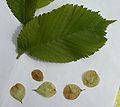Samara (fruit)
Samara or winged nut is the name given to winged, single-seeded or multi-seeded and nut-like (achene or nutlets), dry, non-emergent closing fruits, flying fruits. Some fruits of the papilionaceous plants are also samaras, although they are in the legume family, for example, the fruits in the genus Myroxylon.
The wing is a flat, more or less membranous fringe of the fruit, which forms from the pericarp and serves as a flight organ for wind dispersal. They occur, for example, in birch, ash and elm trees. There can be one, but also several (samaroid) wings, as in birch trees, in the genus Combretum in the wing family, or in rhubarb (Rheum rhabarbarum). A further distinction is made between the double winged nut, as is typical in the maples (Acer spp.), or even multiple, each forming split fruits.
The term samara was already used by Pliny for the fruits of the elm. Joseph Gärtner introduced the term to modern botany in 1788 in his work De fructibus et seminibus plantarum.
There are also winged fruits (Pseudosamara, Diclesium), in which the wings are not formed by the pericarp, but by the perianth or the receptacle, and which combine with the fruit to form a diaspore capable of flight, e.g., valvae. Also, bracts and bracteoles may surround the fruit in a wing-like manner or enclose it in a sac-like manner.
Also possible are "wing capsules," capsule fruits; here the seeds are released when they split, as in Dodeana, as opposed to the split fruits of double or multiple wing nuts.
· 
wing nuts of elms, ash trees and the typical double wing nut of maples
·
Wing nuts and leaves of mountain elm tree
· 
Birch double winged walnut
· 
Four-winged wing nuts of Combretum zeyheri
· 
trifoliate "wing capsule" of Dodonaea coriacea
· .jpg)
Wing fruit (Pseudosamara) of Dipterocarpus bourdilloni with the sepals grown to wings
· 
Pseudosamara of Tilia cordata with the bract serving as a wing
· .jpg)
"Wing capsule" of Carpotroche platyptera with many wings.
However, winged seeds (wing seeds) can also be formed, as in Alsomitra macrocarpa or Rosa Pandorea (Pandorea jasminoides); but here the wings are formed by the seed coat (testa) and not by the pericarp.
There are also wingnuts (Pterocarya), a genus of plants in the walnut family (Juglandaceae) whose fruits are wingnuts.
Search within the encyclopedia
